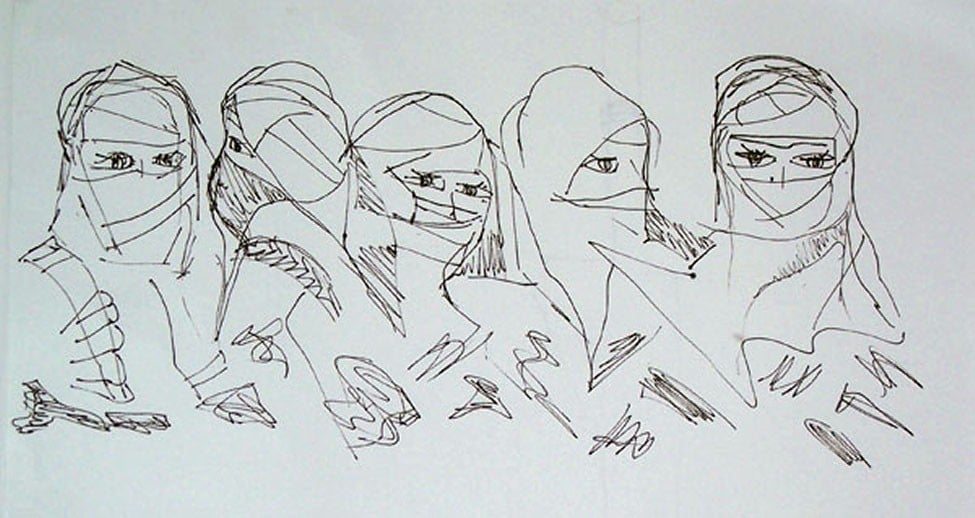
Is covering one’s face just a dress choice? Or does it turn the very notion of female emancipation on its head?

Ever since Imran Khan acknowledged his marriage to Bushra Wattoo, photos of their nikkah ceremony began circulating on social media. One couldn’t help but notice that Bushra, unlike the other women in the photos, had chosen to veil herself fully so that she is invisible to the public. Several comments were passed in reference to her veil.
While many criticised this practice and called it regressive, others came to her defense, stating that it was her choice to dress in the manner she deemed fit and that we had no right to be judgemental. Some went so far as to say that questioning Bushra’s veil was misogynistic.
The problem with this argument is that it turns the very notion of female emancipation on its head. The basic premise of feminism rests on a belief in equality between the sexes. Women’s rights activists have struggled for decades to claim public places for women. Whether it was the right to vote, a demand for equal pay or the opportunity to work in fields historically thought ill-suited to women, such as in the case of fighter pilots, for example, women fought for equality on the grounds that they were as capable as their male counterparts.
The veil creates insurmountable obstacles for women and disables them from achieving goals men take for granted. Covering one’s face isn’t just a dress choice. It means placing severe constraints on one’s ability to interface with the public, and seriously restricting the possibility of earning a livelihood. Why would anyone make such a drastic choice? What is the rationale behind it?
A simple conversation with women who choose to go this route will make it abundantly clear that their interpretation of religion is one where women and men must practice strict segregation. And indeed, in societies where the veil is commonplace, it is considered sinful for women to interact with men who do not fall in the mehram category.
This means that several restrictions are imposed on women to deny them their rightful place in the public sphere. Is it a mere coincidence, for instance, that after the Iranian revolution in 1979, when Iran tightened the dress codes for women, and the veil became far more prevalent, women were also expelled from important positions that they had previously held, such as serving as judges? Moreover, can we not hold the philosophy behind veiling accountable for the deaths of 15 schoolgirls in Mecca back in 2002, when a fire broke out in a girls’ school but na-mehram fire-fighters could not enter because the girls were not properly veiled at the time?
It is such thinking, the idea that in any interaction between men and women, there is the possibility of sin, which must be avoided at all cost, that has led women to die in emergencies in other countries as well because, for example, no female doctor was available, and male doctors wouldn’t be kosher. Is this really the type of thinking we want to recognise as a legitimate choice, particularly at a time when Pakistan ranks so abysmally in maternal mortality?
I am often reminded of Egyptian feminist and women’s rights activist, Mona Eltahawy’s explanation in her book, Headscarves and Hymens, wherein she writes that women are often convinced of the value of veiling "by comparing them to objects that are precious but devalued by exposure, objects that need to be hidden, protected and secured."
In her conversation with a niqab-clad woman, who is trying to impress upon Mona the importance of veiling, she is asked, "If you want to eat a piece of candy would you choose one that is in a wrapper or an unwrapped one?"
"I’m a woman, not a piece of candy," Mona had matter-of-factly replied.
For the overwhelming majority of women veiling isn’t a choice. They are forced into burqas, abayas or chadors against their will and expected to confine their existence within the four walls of their homes. For a small minority, like Bushra, who had the benefit of an education, exposure and travel but nevertheless made this choice, they lend credence to the view that women are not fit to perform several tasks, including something as simple as riding a bicycle (imagine doing that fully veiled) and hence dependent on and in need of protection from male guardians. The number of women veiling themselves in a community has a direct bearing on the status of women in that community.
To be sure, trailblazing women like Asma Jahangir or Bilquis Edhi, would not have been able to accomplish what they did had they been veiled.
I am pleased that both Saudi Arabia and Iran, two countries that had patronised the veil most vociferously in the last three decades, are finally seeing the light on this matter. And certainly, it is no coincidence that as Saudi Arabia moves towards allowing women the right to drive and enter sports stadiums, it has also decided that the abaya and the veil are no longer necessary.
It will take a long time before women can become equal participants there, but it is certainly refreshing to see many more unveiled Saudi women asserting their identities, as men do, instead of remaining nameless and faceless, as they did previously.